9fab4a0846d30746bc14932c0c186c19.ppt
- Количество слайдов: 177

6. 837 Assignment 10 Presentations December 7 th & 9 th, 2004

Mike E.

Distributed Ray Tracing • Effects created by sending many rays from a random distribution. • Used for depth of field effects, glossy reflections, and soft shadows • My implementation reused Sampler and Film objects for creating distribution average

Depth of Field results. . . Normal Scene Yellow Ball focus Blue Ball Focus

Ning S.

Distribution Raytracing To be random is to be realistic. Ning Song 6. 837 Assignment 10 Presentation 12/07/04

Soft Shadows • Light sources in the real world have area. • Represent light source as infinite number of points. • For each shadow ray, sample a random point on light source. • Be sure that pixel and shadow samples don’t correspond. • Note that number of samples has significant impact on image quality.

Point light, no soft shadows Area light, soft shadows, 16 samples/pixel Area light, soft shadows, 64 samples/pixel

Depth of Field • Real world camera has area (vs. usual pinhole camera model) • Model camera (eye) as square or circular disk with area a. • Sample various eye positions on disk while maintaining line of focus (i. e. , sample from focal plane). http: //glasnost. itcarlow. ie/~powerk/Graphics/Notes/node 1 2. html#SECTION 0012800000000 • Larger lens size means more things out of focus, smaller lens size means more in focus.

Perfect focus Small lens size Large lens size

Glossy Reflection • Glossy surfaces have non-ideal reflections (i. e. , blurry reflections). • Implement by varying reflection rays (i. e. , sampling reflection ray directions). • For each surface hit point, perturb ideal reflection ray using perpendicular square with length a, which is degree of blurriness.

Perfect reflection Glossy Reflection, 16 samples/pixel Glossy reflection, 64 samples/pixel

Motion Blur • Image is formed over non-zero span of time. • For each ray, pick a random time between t_start and t_end, and intersect with moving primitive. • Resulting image will again be blurred. • Important to specify both start and end positions of object in order to calculate bounding boxes for ray acceleration.

T=0 T=5 T = 10

(1) James T.

Triangle. Mesh. Group & CSGs James Tolbert, II Assignment 10 Presentation 6. 837

Triangle Mesh Group • No new Object 3 D, Group subclass • Only Override the inside Method • Parse calls Triangle. Mesh. Group

Pictures Difference Intersection Union

CSG Plane

Some of Text File • • Group { num. Objects 6 • • • • • • • Transform { Translate 0 0 1 Group { num. Objects 2 Transform { Translate 3 3 0 Scale 0. 5 0. 6 0. 5 Group { num. Objects 4 Material. Index 0 Transform { Scale 2 2 2 Group { num. Objects 1 Difference { Triangle. Mesh { obj_file cube. obj } Sphere { center 0 1 0 radius 0. 8 } } Transform { Translate 0 5 0 Scale 1 5 1 XRotate 180 Group { num. Objects 1 Intersection { Triangle. Mesh { obj_file cube. obj } Sphere { center 0 1 0 radius 1 } } Transform { Translate 0 -5 0 Scale 1. 5 4 1. 5 Group { num. Objects 1 Intersection { Triangle. Mesh { obj_file cube. obj } Sphere { center 0 1 0 radius 1 } } Transform { Translate 0 2 0 Scale 1. 4 0. 5 1. 4 XRotate 180 Group { num. Objects 1 Intersection { Triangle. Mesh { obj_file cube. obj } Sphere { center 0 1 0 radius 1 } } } Material. Index 1 Transform { Translate 3 3 4 XRotate 90 ZRotate 90 YRotate -90 Scale 1. 5 0. 5 3 XRotate 90 Group { num. Objects 1 Intersection { Triangle. Mesh { obj_file cube. obj } Sphere { center 0 1 0 radius 1 } } } Material. Index 3 Transform { Translate 5 -8 1 Scale 0. 5 Group { num. Objects 2 Transform { Scale 1 5 1 Group { num. Objects 1 Intersection { Triangle. Mesh { obj_file cube. obj } Sphere { center 0 1 0 radius 1 } } Transform { Translate 0 11 0 Scale 1 5 1 XRotate 180 Group { num. Objects 1 Intersection { Triangle. Mesh { obj_file cube. obj } Sphere { center 0 1 0 radius 1 } } } Material. Index 1 Transform { Translate 5 -9 0 Scale 1. 2 1. 5 1. 2 Group {

(2) Colin W.




(3) Javier C.

Tensor Product of BSpline Curves Javier Castro MIT 6. 837

Definitions • What is a Tensor Product? • Definition of BSpline Patch – Can be of size M x N – Has two parameters: s and t

Problems • BSpline Patch vs. Bicubic Bezier Patch • 3 D Point Editing via GUI

Example

Fun with BSpline Surfaces

(4) Evelyn E.

Ray Tracing Quartic Surfaces Evelyn Eastmond 6. 837 Assignment 10

Ray-Torus Intersection • A Torus is a quartic surface Quadratic surface - 2 roots Quartic surface - 4 roots

Ray-Torus Intersection • Torus equation: – f(x, y, z) = (x 2 + y 2 + z 2 –r 2 – R 2)2 +4 R 2(z 2 – r 2) – x = rox + rdx, y = roy + rdy, z = roz+rdz • Steps – Find coefficients of quartic • By hand (1. 5 hrs…. ) • Online – Solve using quartic solver • By hand? • Online!

Ray-Torus: Failed Attempt 1 • Problem: inverted coefficients

Ray-Torus: Failed Attempt 2 • Problem: false positive ‘t’ values

Lessons Learned • Solve everything by hand – geometry? • Use online sources for reference only • Acknowledgements: – Ray-torus equation: Max Wagner, http: //emeyex. com/ – Quartic solver: Geant 4 Group, http: //geant 4. web. cern. ch


(5) Andy A.

Distribution Ray Tracing Andy Arizpe 6. 837 December 9, 2004

Soft Shadows • Represent light source as area rather than point. • For each shadow calculation, send multiple rays aimed at different points on the light. • Points near the border of the shadow region will be partially lit.

Soft Shadows One ray per shadow calculation Sixteen rays per shadow calculation

Glossy Reflection • Used to model materials that are somewhere between perfect mirrors and diffuse. • For each reflection, send several rays – each one offset from the perfect mirror direction by a random vector, calculated by sampling a square perpendicular to the perfect mirror direction. • Size of square determines amount of blurriness.

Glossy Reflection Three spheres with glossiness values of 0, 0. 25, and 0. 5 (from left to right).

Depth of Field • Extend the perspective camera with notions of lens size and distance to focus plane. • For each pixel, shoot multiple rays originating at different points on the “lens”, but all going through the same point on the focus plane. • With a larger lens size, objects get blurrier more quickly as you move away from focus plane.

Depth of Field No focus – standard perspective camera Focus on blue box Focus on red box

(6) Ilia M.

f(r) = exp(-r 2/2) f(r) = r < 1: (1 -r 2)2 r ≥ 1: 0

video… PLAY VIDEO

(7) Bryan A.

Environment. Objects • • Env. Sphere and Env. Plane Float get. Distance(Vec 3 f pos) Vec 3 f get. Normal(Vec 3 f pos) Void paint() • Each system has an array of Environment. Objects, so you can have several in a scene

Basic Collision Detection For each particle Update (using the Integrator) For each Environment. Object Calculate time of collision (-1 if no collision) if (collision_time >= 0) Collision response

Backtracking Collision Detection For each particle curr_dt = dt While (curr_dt >= 0) Update (using Integrator) for curr_dt For each Environment. Object Calculate first collision (if any) If collision Revert to last state (last_pos and last_vel) Update system until collision (dt - max_time) Collision response curr_dt = max_time

Particle Representation • Normal particles, spheres, and cubes • Float collision. Time(Env. Object* env. Obj) – Use env. Obj->get. Distance(…) & ->get. Normal(…), last_velocity and radius • Void collision. Response(Env. Object* env. Obj) – Mirror reflection • Void paint() • Cubes consist of a group of six particles set around a center point (only the center point is sent to the Update function)

Backtracking vs. Normal Collision Response Normal Backtracking

Setup Environments Cube -> 6 Env. Planes Sphere -> 1 Env. Sphere

Setup Environments (cont. ) Triangular Bar -> 5 Env. Planes Square Pyramid -> 5 Env. Planes

Setup Environments (cont. ) Four-sided Pyramid -> 4 Env. Planes

Cube Pics Cube Inside an Env. Sphere Cube Inside a Cube (6 Env. Planes)

(8) Mariana B.





(9) Kenfield G.

KENFIELD GRIFFITH




(10) Nestor H.

Nestor Hernandez: Photon Mapping mishaps ~2500 photons 10000 photons 20000 photons

Nestor Hernandez: Photon Mapping

(11) Matthew W.

Cellular Textures Matthew Webber

• Scale Transform • Crack Width • # of foci

Transparency

Reflection/Refraction

Bump Mapping

Projective Shadows

Grand Finale. . .


(12) Lawrie G.

Constructive Solid Geometry • Three operations: – Union – all points in object A and all points in object B – Intersection – all points in objects A and B – Difference – all points in object A but not in object B

Constructive Solid Geometry

(13) Kevin D.

demo…

(14) Yan(James) P.

Collision Detection 6. 837 Final Assignment By Yan(James) Pang

Introduction • Importance for physical simulation, e. g. Virtual reality, Augmented reality, etc. • Most of objects in VR application are defined by triangle meshes • The important collision problem is to solve the collision between two triangles

Two Scenarios of Triangle Collision • Coplanar • Non-coplanar

Coplanar Triangles • Intersection – Edge-Edge Collision • • AB = A + r(B-A) CD = C + s(D-C) Compute r, s A + r(B-A) = C + s(D-C) ? r, s in [0, 1] • Inside – Vertex inside Triangle? – Optimal algorithm: reduce dimension (3 D to 2 D) • No Collision

Non-Coplanar Triangles • Non-coplanar triangles Collision – Intersection Line (L) – Project the vertex on the Intersection Line – Compare the Projected Intervals of vertex L

Results • Objects Defined by Triangle Mesh – Report how many triangles collide Object 2 Object 1 • Non Triangle Mesh Objects – Just report whether they are collided Object 0 Object 4 Object 3

(15) Emily W.

DISTRIBUTIONRAYTRACING 6. 837 EMILYWHITING

focus plane + lens perturbing eye position DEPTHof. FIELD

spherical light source SOFTSHADOWS

perturbed reflection ray GLOSSYREFLECTIONS

ANTIALIASING +SOFTSHADOWS +GLOSSYREFLECTIONS

(16) Dumitru D.

Ray tracing implicit surfaces 6. 837 Lab 10 Dumitru Daniliuc dum_dani@mit. edu

How do we define a surface? • defined by a polynomial P(x, y, z) = 0 • input file: surface 3 d { polynomial x^2+y^2+z^2 -1 }

Some images Sphere object Transformation of a Sphere object Surface 3 D object: x^2+y^2+z^2 -1 Surface 3 D object: x^2+4*y^2+z^2 -1

Add “cutting planes” • Separates the space into two half-spaces • Exactly one half-space is visible • The normal determines which half-space is visible

More input file extensions • Defining a surface with “cutting planes”: surface 3 d { polynomial x^2+y^2+z^2 -1 num_cutting_planes 2 cutting_plane { normal 0 0 -1 offset -0. 7 } cutting_plane { normal 0 0 1 offset -0. 7 } planes_conditions 1&2 }

More images • double cone: 16*x^2+z^2 -4*y^2 • 16 cutting planes • planes_conditions: (1&2)|(3&4)|(5&6)|(7&8)|(9&10)| (11&12)|(13&14)|(15&16) • hyperbolic paraboloid: x^2 -z^2 -8*y (with 2 rotations) • 3 cutting planes • planes_conditions: 1&2&3

What about solid objects? • How do you cover the “holes”? • Adding intersections with the “cutting planes” does not work • Other easy methods don’t seem to work either • Find the surface intersection with every “cutting plane”?

(17) Andrew W.

demo…

(18) Diane Y.

Constructive Solid Geometry (CSG) union intersection subtraction

How can we implement CSG? Points on B, Outside of A Points on A, Outside of B Points on B, Inside of A Union Points on A, Inside of B Intersection Subtraction

Collect all the intersections Union Intersection Subtraction

Implementing CSG 1. Test "inside" intersections: • • 2. Find intersections with A, test if they are inside/outside B Find intersections with B, test if they are inside/outside A Overlapping intervals: • • Find the intervals of "inside" along the ray for A and B Compute union/intersection/subtraction of the intervals

CSG with spheres union intersection subtraction

CSG with triangles/planes original intersection w/ triangles intersection w/ plane

Nested CSG’s Mickey Saturn Snowflake ball Union of 3 spheres Union of sphere and transform Union of 4 transforms, intersection with sphere

A snowman

A snowman Triangle/sphere union Sphere subtraction + triangle mesh Triangle meshes Sphere subtraction Snowflake/plane intersection Transform/CSG union (with noise for the sky and ground)

(19) Abraham E.

depth = 2 depth = 5 depth = 100



(20) Daniel W.

SUBGRIDS Daniel Wendel

-subgrid edge min. D threshold max. D

-grid 2 2 2 -subgrid 2 0 16 10

-grid 2 2 2 -subgrid 2 0 16 10

-grid 3 3 3 -subgrid 7 0 18 6

(21) Ioannis T.

demo…

(22) Emily Y.

NPR Post-Processing of Images: Giving pictures a more personal touch Emily Yan December 9, 2004

What is NPR? • NPR = Non-Photorealistic Rendering • Millions of different effects (AKA Photo. Shop filters) • Original goal: cross-hatch • Use a sawtooth pattern to compare original grayscale image

Sawtooth Function • Linear interpolation of grays • Careful balance of repeat rate – Too high: bands are too wide, unable to catch a great deal of detail – Too low: not enough shades of gray, causes it to be difficult to capture differences in color Original Rep rate: 4 Rep rate: 20

Options • Horizontal/Vertical Bars – Slope – Scale – Offset • Mesh • Rings • Stipple

Equalization Required Normal Pattern Output Equalized Sometime your pattern is just too dark…

Eye Candy Uses mesh, equalize

Eye Candy Stipple effect

Eye Candy Uses rings

(23) Tom H.

Distribution Ray Tracing Effects Tom Hoover 6. 837

Soft Shadow • Finite sized lights • For each intersection sample over light • Sampling over cone, not uniform distribution

Motion Blur • Give ability for objects to have a start and an end point • Keep track of time during the entire raycasting process • For each pixel, sample over random time

Glossy Materials • Simulate the imperfections in surfaces • Perturb reflected rays and continue to trace • Sample using uniform distribution (over normal plane to reflected ray)

(24) Eric L.






(25) Rohit R.

CSG Rohit Rao 6. 837 12/9/04

CSG Operations
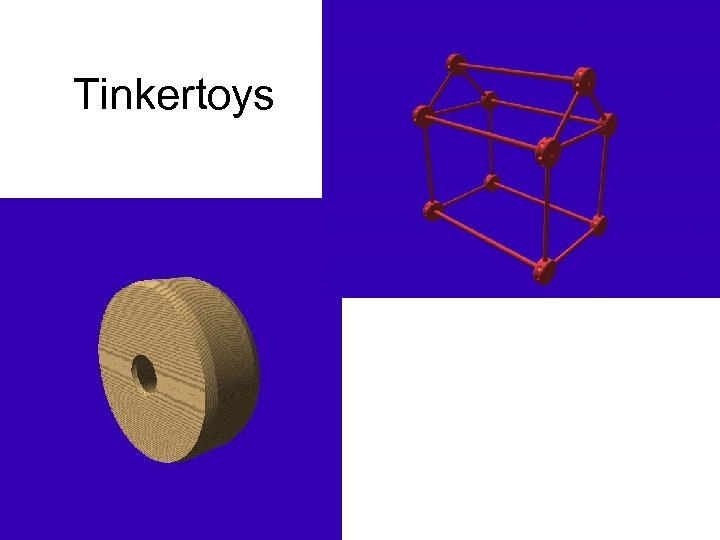
Tinkertoys
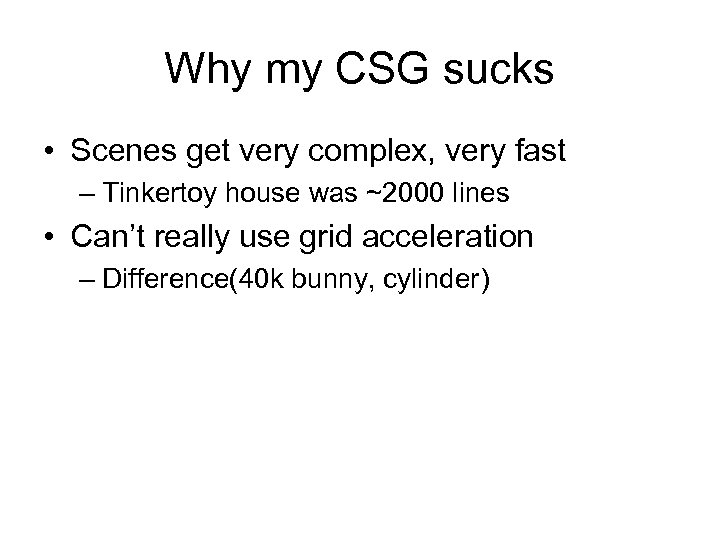
Why my CSG sucks • Scenes get very complex, very fast – Tinkertoy house was ~2000 lines • Can’t really use grid acceleration – Difference(40 k bunny, cylinder)
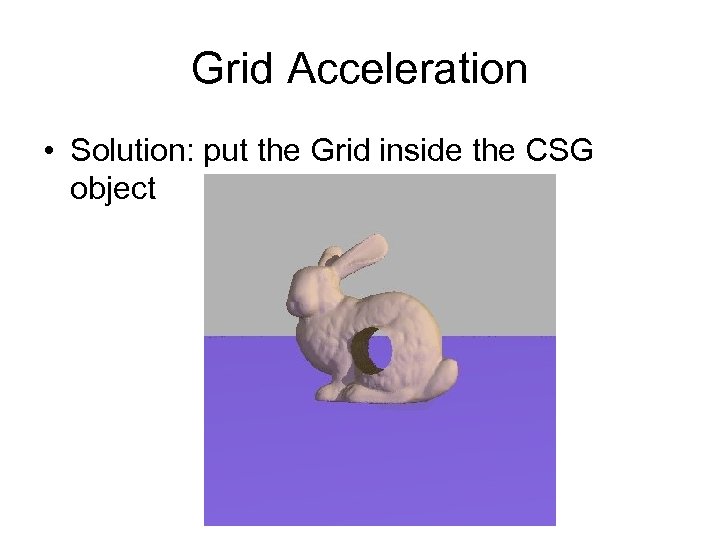
Grid Acceleration • Solution: put the Grid inside the CSG object
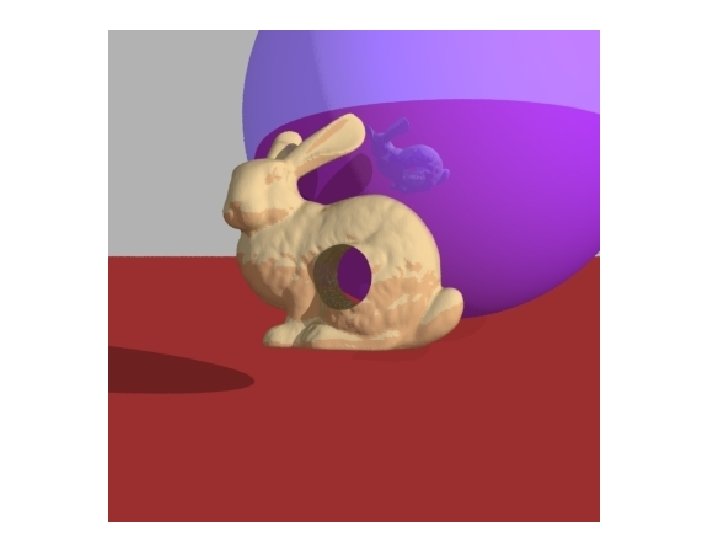

(26) Annie D.
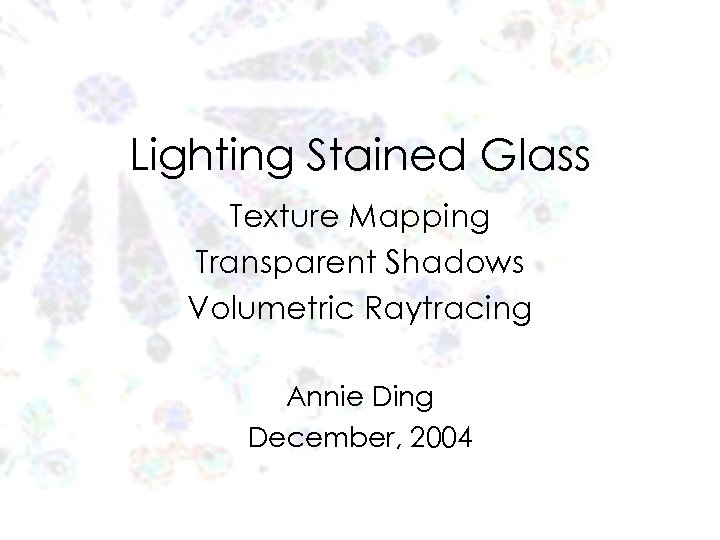
Lighting Stained Glass Texture Mapping Transparent Shadows Volumetric Raytracing Annie Ding December, 2004
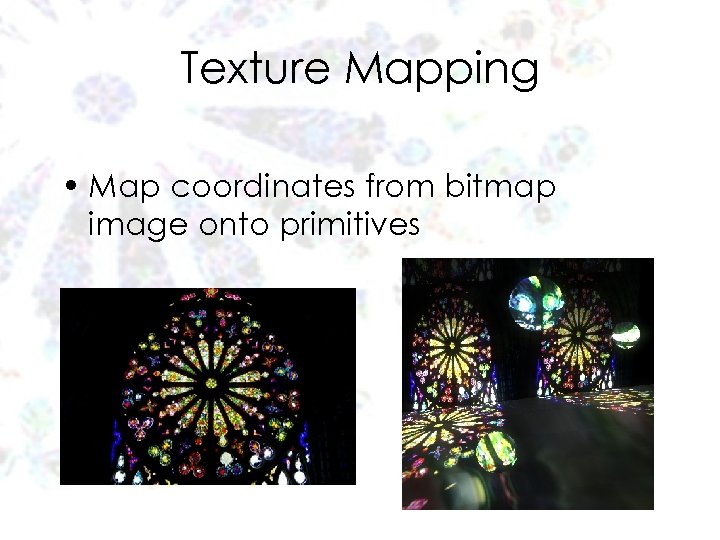
Texture Mapping • Map coordinates from bitmap image onto primitives
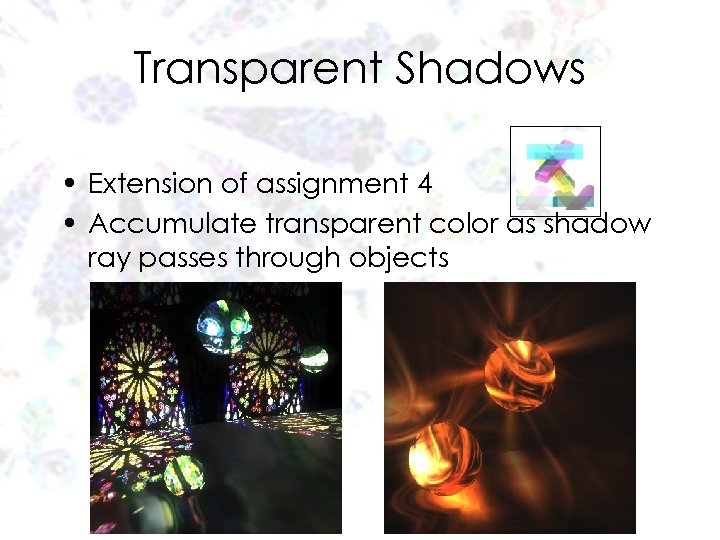
Transparent Shadows • Extension of assignment 4 • Accumulate transparent color as shadow ray passes through objects
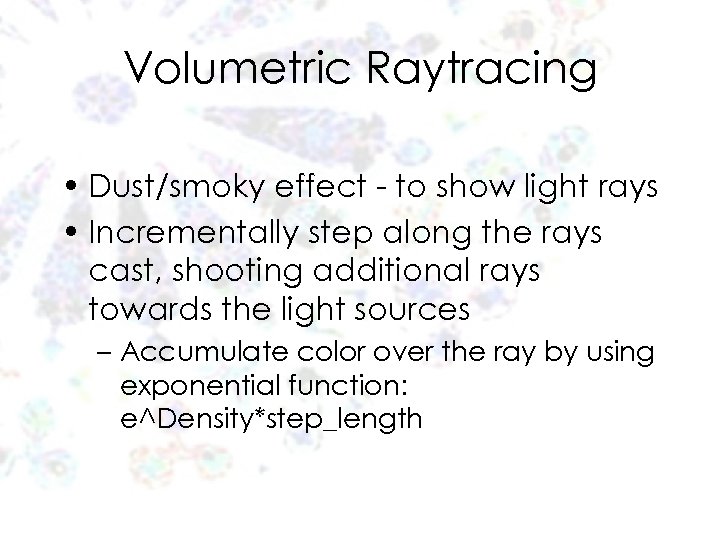
Volumetric Raytracing • Dust/smoky effect - to show light rays • Incrementally step along the rays cast, shooting additional rays towards the light sources – Accumulate color over the ray by using exponential function: e^Density*step_length
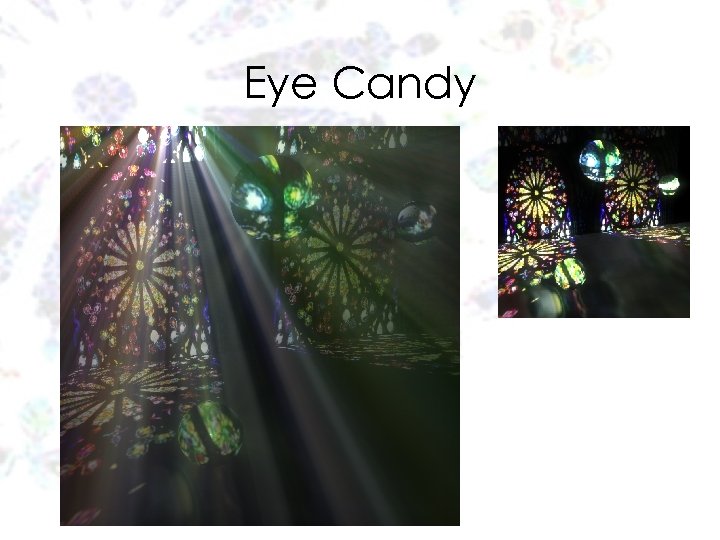
Eye Candy
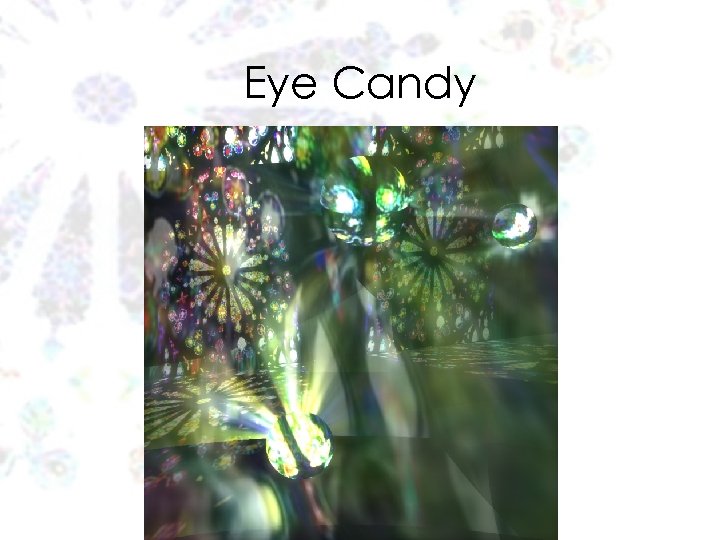
Eye Candy
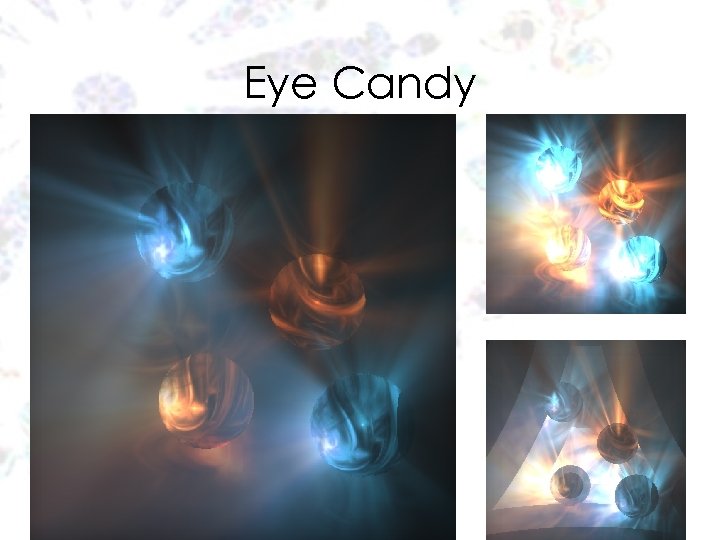
Eye Candy

(27) Jim G.
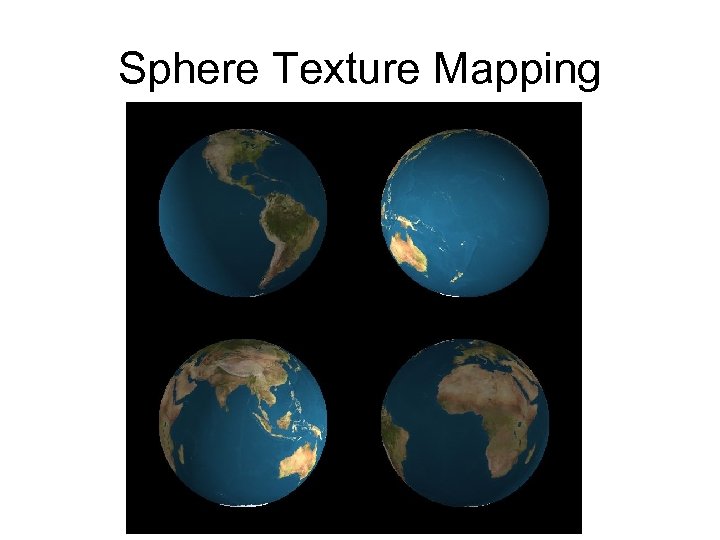
Sphere Texture Mapping
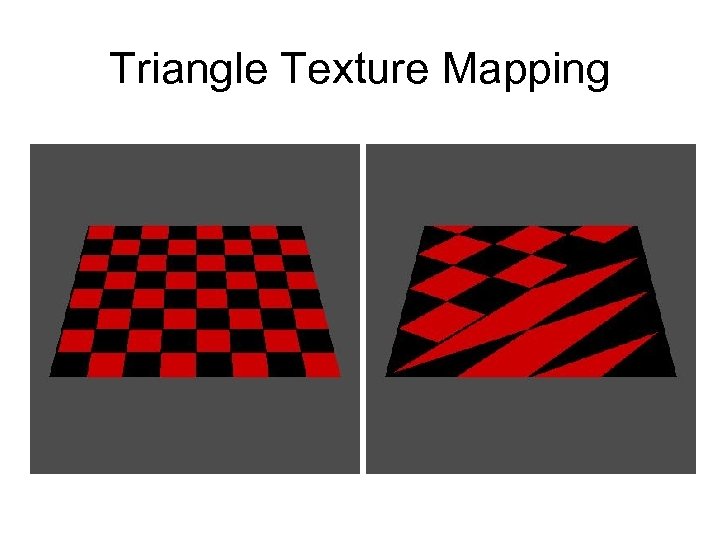
Triangle Texture Mapping
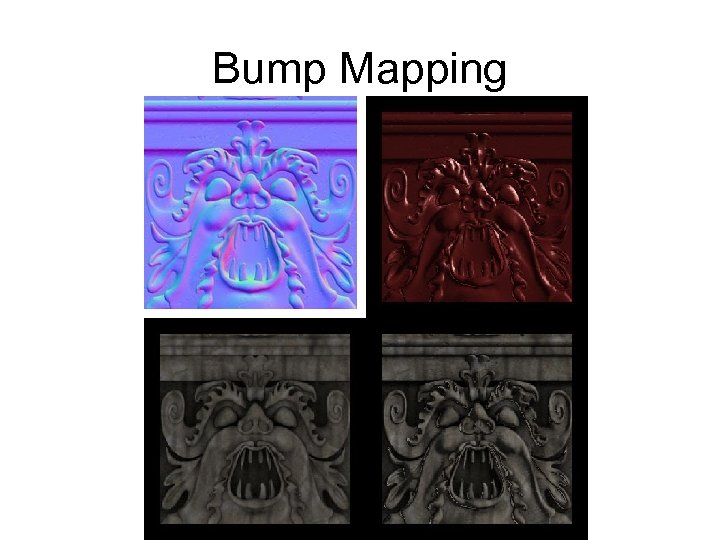
Bump Mapping
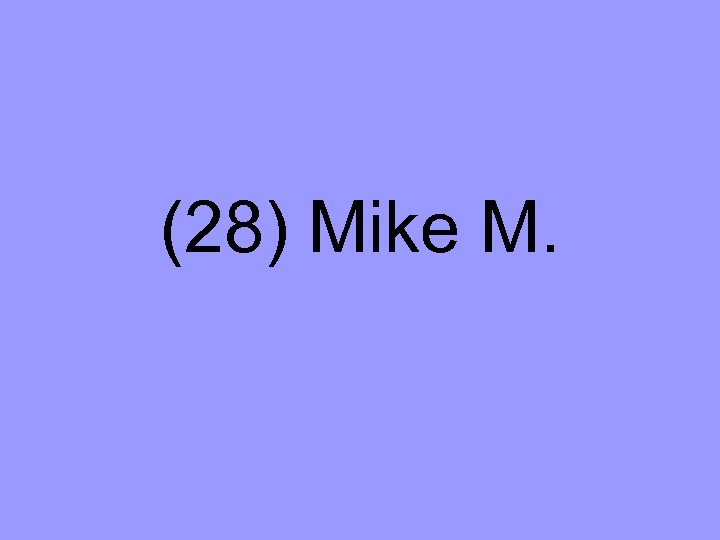
(28) Mike M.
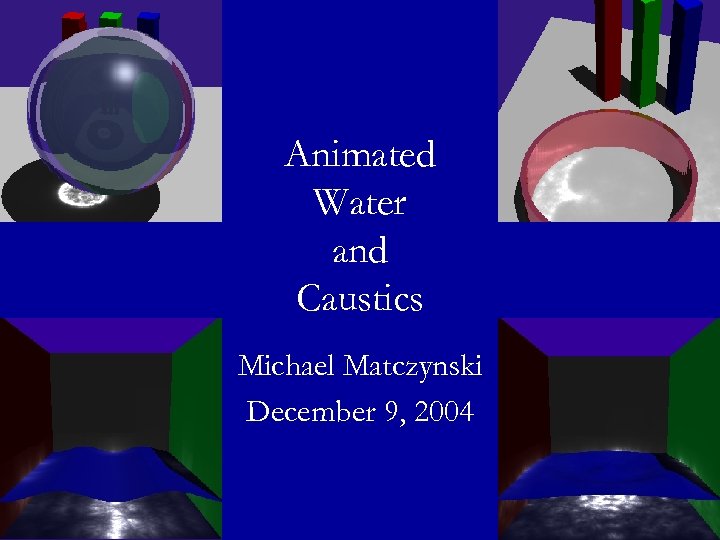
Animated Water and Caustics Michael Matczynski December 9, 2004
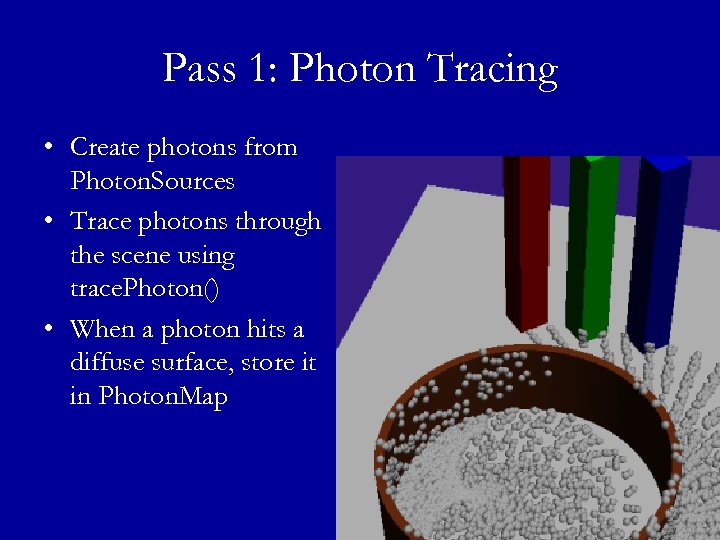
Pass 1: Photon Tracing • Create photons from Photon. Sources • Trace photons through the scene using trace. Photon() • When a photon hits a diffuse surface, store it in Photon. Map
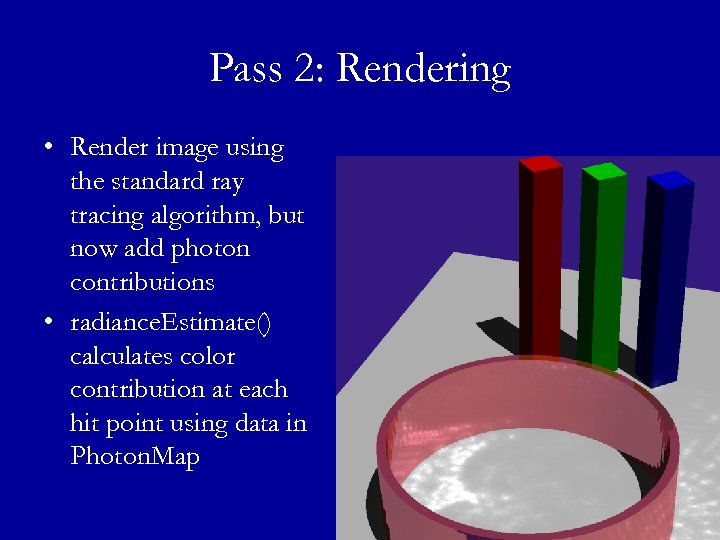
Pass 2: Rendering • Render image using the standard ray tracing algorithm, but now add photon contributions • radiance. Estimate() calculates color contribution at each hit point using data in Photon. Map
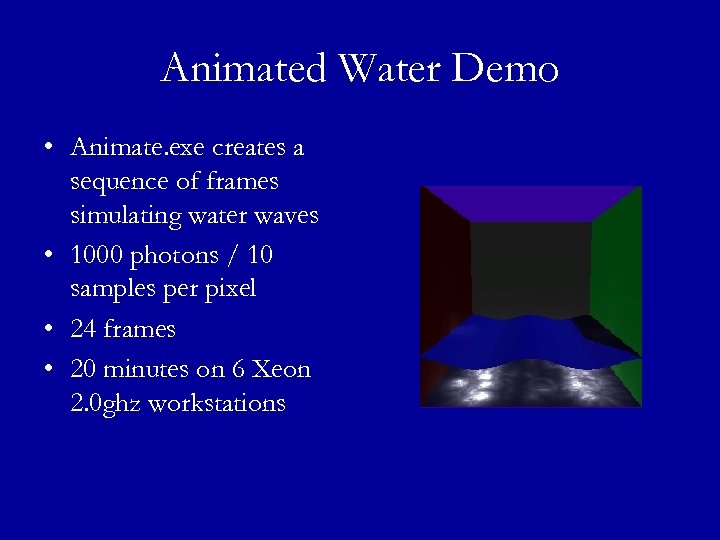
Animated Water Demo • Animate. exe creates a sequence of frames simulating water waves • 1000 photons / 10 samples per pixel • 24 frames • 20 minutes on 6 Xeon 2. 0 ghz workstations
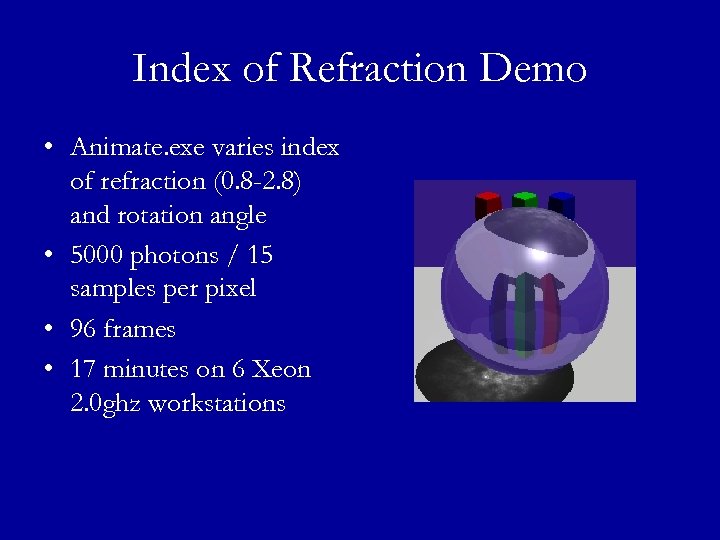
Index of Refraction Demo • Animate. exe varies index of refraction (0. 8 -2. 8) and rotation angle • 5000 photons / 15 samples per pixel • 96 frames • 17 minutes on 6 Xeon 2. 0 ghz workstations
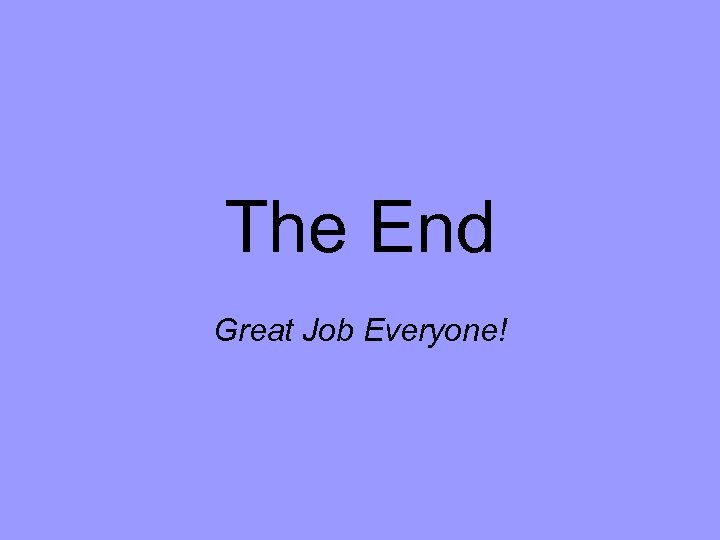
The End Great Job Everyone!
9fab4a0846d30746bc14932c0c186c19.ppt